 What percent of your B2B sales force made quota in 2017? A CSO Insights survey suggests that 57% is the average. This means that 43% didn’t meet goal. Getting better performance out of the middle 80% of the sales force is an obvious way to meet target sales growth in 2018.
What percent of your B2B sales force made quota in 2017? A CSO Insights survey suggests that 57% is the average. This means that 43% didn’t meet goal. Getting better performance out of the middle 80% of the sales force is an obvious way to meet target sales growth in 2018.
To improve average rep performance, sales management and their sales enablement team call in the experts. There are too many great firms to name, but thought-leading experts in B2B sales include Richardson, CEB (now Gartner), Miller Heiman, Corporate Visions, Sirius Decisions, Forrester and Aberdeen. Each of these firms has distinct approaches, but in general they: (1) identify success and/or challenges, (2) assess the sales practices that lead to success and (3) refine the sales process. This refined sales process incorporating best practices is then deployed through sales training, management coaching and the right sales tools to enable reps in the middle of the bell-shaped curve to increase their sales productivity. Sales enablement initiatives usually aim to improve the sales performance of the 80%.
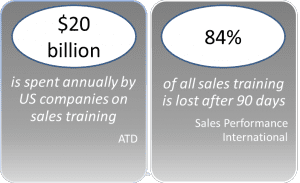 Sales Training is Not Enough. $20 billion is spent annually by US companies on sales training, yet 84% of all sales training is lost after 90 days. Training and coaching are not enough. Field marketing and sales enablement teams, need to provide the right content and tools for the sales skills and sales methods to take hold. Sales content and sales tools should be useful, not only to sales managers and sales coaches but also directly to sales professionals for call preparation and for use in the limited and valuable time that they spend with customers in conversation.
Sales Training is Not Enough. $20 billion is spent annually by US companies on sales training, yet 84% of all sales training is lost after 90 days. Training and coaching are not enough. Field marketing and sales enablement teams, need to provide the right content and tools for the sales skills and sales methods to take hold. Sales content and sales tools should be useful, not only to sales managers and sales coaches but also directly to sales professionals for call preparation and for use in the limited and valuable time that they spend with customers in conversation.
The Challenges Sales Tools Should Address. The sales experts inform their own practice and content by understanding the perspectives of both buyers and sellers. Let’s start  with the buyers’ perspective. An Aberdeen PJA survey asked buyers to select the two factors that play the greatest role in their decision to purchase a product or solution. Their top 3 answers in order were:
with the buyers’ perspective. An Aberdeen PJA survey asked buyers to select the two factors that play the greatest role in their decision to purchase a product or solution. Their top 3 answers in order were:
- Total Cost of Ownership.
- How the vendor’s solution supports the customer’s goals.
- ROI and efficiency gains.
Sellers have their own perspective on what they need. A survey conducted by Richardson 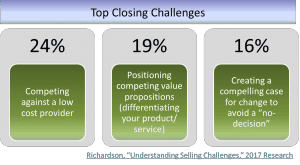 asked commercial executives about their single, top closing challenge. Their first three responses were:
asked commercial executives about their single, top closing challenge. Their first three responses were:
- Competing against a low-cost provider.
- Differentiating your product or service by positioning a competing value proposition.
- Creating a compelling case to change versus no decision.
Value Propositions Address Sales Challenges. Value Propositions provide a tool to engage in an evolving conversation with customer stakeholders about what your solution can  do for them. Good Value Propositions provide clear answers to simple questions:
do for them. Good Value Propositions provide clear answers to simple questions:
- Can you deliver meaningful, reliable business results to customers like us?
- What are the 2 or 3 impactful differences between your solution and the alternatives?
Qualitative answers to these questions in a Value Proposition provide core content that address a majority of the sales challenges above. They point directly toward how the seller supports the customer’s goals. They position the seller’s differentiation, supporting the case vs low cost providers. Strong qualitative messages in a Value Proposition establish the reason for a customer to change at all, providing content to address customer stakeholders tempted toward the status quo and “no decision.”
But the best Value Propositions go beyond good qualitative messaging. What you do for your 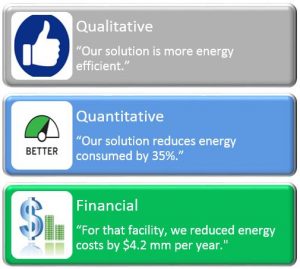 customers can be expressed in three ways:
customers can be expressed in three ways:
- Qualitative
- Quantitative
- Financial
Quantitative and Financial answers provide sellers with a way to engage a buyer in the direct assessment of Total Cost of Ownership and ROI and efficiency gains that they are likely to perform with or without the seller’s input. They also provide stronger content to address and validate a solution’s differentiation, its competitive positioning vs a low cost provider and why “no decision” is an inferior option.
Providing sales with quantitative and financial validation with stand-alone ROI and TCO calculators is not the best approach. Financial conversations are not necessarily appropriate for all stakeholders and all stages of the sales cycle. Value Propositions should be designed to play a flexible and versatile role in the sales process. Value Propositions work best if their content – qualitative, quantitative and financial – is layered to facilitate the right conversation with the right stakeholder at the right time.
What do the Sales Experts Recommend? Given the challenges identified by the sales experts, it should come as no surprise that their recommendations point directly toward Value Propositions as a key piece, if not THE key piece of content for sales team conversations with customers. Although sales processes coming from different experts have different emphases, it is remarkable how much they have in common. Here are 6 examples.
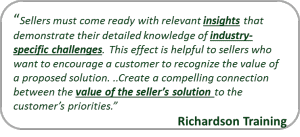 Richardson Training, in their approach to consultative selling, highlights that “sellers need to come with relevant insights, and knowledge of industry specific challenges” to “create a connection between the value of their solution and the customers’ priorities.” Value Propositions provide those insights and knowledge.
Richardson Training, in their approach to consultative selling, highlights that “sellers need to come with relevant insights, and knowledge of industry specific challenges” to “create a connection between the value of their solution and the customers’ priorities.” Value Propositions provide those insights and knowledge.
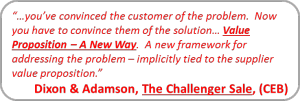 The most read sales book of the last ten years, The Challenger Sale from CEB, now Gartner, highlights that after “you’ve convinced the customer of the problem,” the right framework for this solution, is a Value Proposition.
The most read sales book of the last ten years, The Challenger Sale from CEB, now Gartner, highlights that after “you’ve convinced the customer of the problem,” the right framework for this solution, is a Value Proposition.
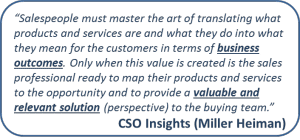 CSO insights, the research organization within Miller Heiman, recommends that “salespeople need to translate products and services to business outcomes. They need to map those products and services to the opportunity and provide a valuable and relevant solution.” Value Propositions provide content that connect solutions to valuable business outcomes.
CSO insights, the research organization within Miller Heiman, recommends that “salespeople need to translate products and services to business outcomes. They need to map those products and services to the opportunity and provide a valuable and relevant solution.” Value Propositions provide content that connect solutions to valuable business outcomes.
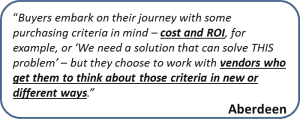 Aberdeen points out that “buyers start with quantitative and financial criteria, e.g. cost and ROI, but that buyers “choose to work with vendors who get them to think about those criteria in new and different ways.” From their perspective, qualitative, quantitative and financial messaging within Value Propositions should all be important.
Aberdeen points out that “buyers start with quantitative and financial criteria, e.g. cost and ROI, but that buyers “choose to work with vendors who get them to think about those criteria in new and different ways.” From their perspective, qualitative, quantitative and financial messaging within Value Propositions should all be important.
 Corporate Visions recommends that sales professionals “build a business case to gain executive buy-in” and that they “elevate value” in their conversations to “give buyers a compelling business reason to change now, and a meaningful business case to help them justify that decision.” Value Propositions provide a business case at a level that executives will understand.
Corporate Visions recommends that sales professionals “build a business case to gain executive buy-in” and that they “elevate value” in their conversations to “give buyers a compelling business reason to change now, and a meaningful business case to help them justify that decision.” Value Propositions provide a business case at a level that executives will understand.
 The advice from the team at Sirius Decisions is that B2B organizations “should have multiple Value Propositions – one to match each target buying audience.”
The advice from the team at Sirius Decisions is that B2B organizations “should have multiple Value Propositions – one to match each target buying audience.”
Regardless of expert differences in approach to sales processes, skills training and management coaching, a common thread for the right customer-oriented content runs through most sales methodologies of the leading B2B sales experts. Sales teams all need to differentiate themselves. Sales teams are all in search of the right content to engage customer executives and to have customer-centric conversations. Sales all need to have a business case for the outcomes their solution will provide in terms that executives will understand. Sales teams all need a Value Proposition.
Everyone Agrees on the Solution, so What’s the Problem? CRM data from organizations adopting value selling show that opportunities where Value Propositions are used have 5-15% higher win rates and 5-25% higher price outcomes. Sales managers agree that using Value Propositions early in the sales cycle results in more qualified opportunities in the funnel. Sales rep interviews highlight that strong Value Propositions improve sales effectiveness, even when they aren’t presented, because Value Propositions build and sustain sales team confidence in their insights into how their solution delivers tangible, verifiable business benefits to customers.
Yet Sirius Decisions found that the number one problem for sales effectiveness is an “inability  to convey their value proposition.” There are three obvious reasons for this:
to convey their value proposition.” There are three obvious reasons for this:
- Sales teams don’t have Value Propositions.
- Sales teams can’t find the Value Propositions they have.
- If teams can find their Value Propositions they can’t use them because they’re too complicated.
Sales feedback along any one of these lines should be evidence that something is missing in the alignment between marketing and sales. But with all the effort and resources being devoted to sales training, there is a fourth potential problem worth identifying:
- Value Propositions are not aligned with the organization’s prescribed sales methodology.
Address the Problem. This should be an easy problem to fix. Yet too often, product managers, marketers and the spreadsheet whizzes who build calculators neglect the  fundamentals of a company’s sales process and the prescriptions of its sales training programs. All it takes is for content creators to assess how a Value Proposition fits the company’s sales methodology and to spend the creative energy to adapt this key piece of content to how sales teams are being trained and coached to sell.
fundamentals of a company’s sales process and the prescriptions of its sales training programs. All it takes is for content creators to assess how a Value Proposition fits the company’s sales methodology and to spend the creative energy to adapt this key piece of content to how sales teams are being trained and coached to sell.
Aligning Value Propositions with your sales methodology provides significant benefits:
- It reinforces the fundamentals of your B2B sales training curriculum focused on customer conversations and customer outcomes.
- It helps to move a core piece of content – the Value Proposition – directly into sales training and sales enablement, building sales confidence in your fundamental messages.
- It improves the quality and sales-readiness of your Value Proposition as a sales tool, improving sales performance.
Value Propositions as Aligned, Sales-Ready Tools. The best B2B enterprises deploy Value Propositions to improve B2B sales team performance, addressing sales challenges in a way consistent with an organization’s sales training, throughout the B2B sales cycle. For  account executives and sales reps, they are useful early in the sales cycle as Flexible Case Studies in call preparation, in building sales confidence, in qualifying opportunities and in engaging customer executives. For technical sales and presales professionals, joining the team in the middle of the sales process, Value Propositions provide Customer Value Analyses as an important consultative selling tool to address presales challenges. As customers decide to purchase, the Value Proposition becomes a Shared Business Case, collaboratively agreed between sales executives and customer sponsors, that serve as a buyer’s internal financial justification to purchase.
account executives and sales reps, they are useful early in the sales cycle as Flexible Case Studies in call preparation, in building sales confidence, in qualifying opportunities and in engaging customer executives. For technical sales and presales professionals, joining the team in the middle of the sales process, Value Propositions provide Customer Value Analyses as an important consultative selling tool to address presales challenges. As customers decide to purchase, the Value Proposition becomes a Shared Business Case, collaboratively agreed between sales executives and customer sponsors, that serve as a buyer’s internal financial justification to purchase.
It isn’t hard to start value selling. Value Propositions provide core sales content that helps sales teams communicate what your solution does for your customers. Value Propositions are a shared basis for collaboration that help sales teams win.

